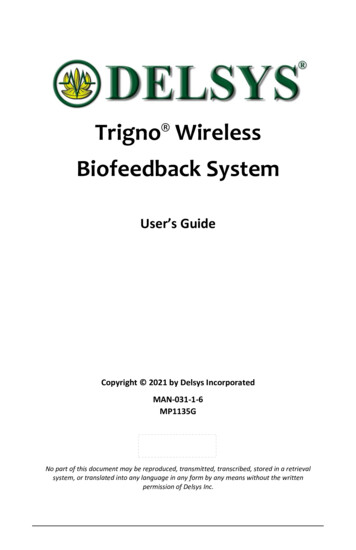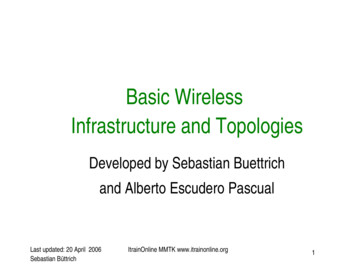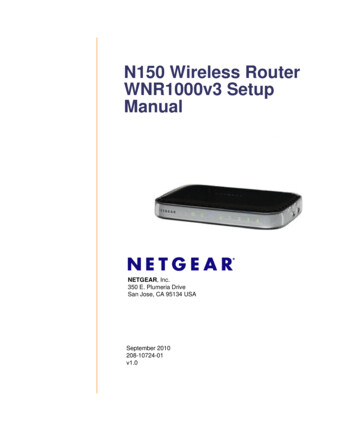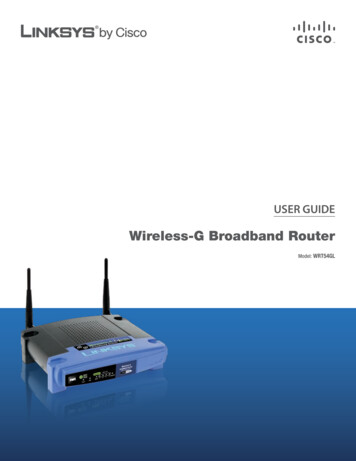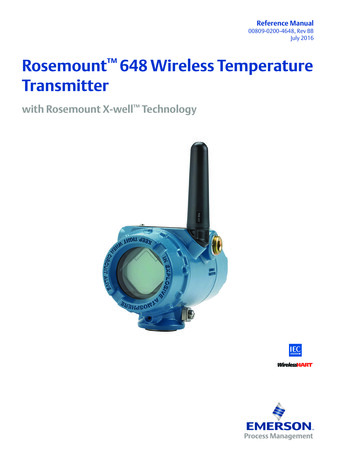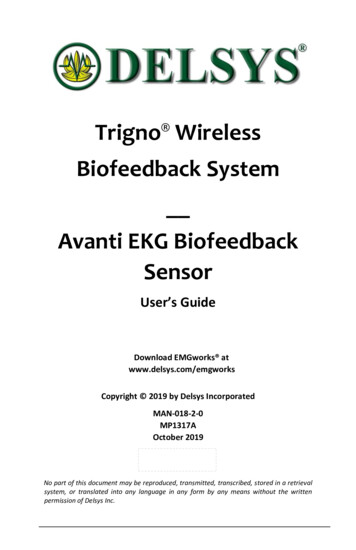
Transcription
Trigno WirelessBiofeedback SystemAvanti EKG BiofeedbackSensorUser’s GuideDownload EMGworks atwww.delsys.com/emgworksCopyright 2019 by Delsys IncorporatedMAN-018-2-0MP1317AOctober 2019No part of this document may be reproduced, transmitted, transcribed, stored in a retrievalsystem, or translated into any language in any form by any means without the writtenpermission of Delsys Inc.
Important Information . 3Intended Use . 3Contraindications . 3Technical Service and Support . 3Warnings and Precautions . 4Device Information . 5Windows PC Requirements . 6Android Device Requirements. 6Trigno System Overview . 7Trigno EKG Sensor Features . 7Differential EKG Sensing . 8Inertial Measurement Unit . 8Dual Mode “BLE-Base” Communication . 8Wireless Communication . 8Data Synchronization . 8Rechargeable Battery. 8Sealed Enclosure . 9Internal Magnetic Switch . 9Sensor LED Feedback States . 9Getting Started with the Trigno Sensor . 11Configuring the Trigno EKG Sensors . 11Using the Analog Outputs (if Equipped) . 11Placing the Trigno EKG Sensor on the Skin . 12Selecting Snap Electrodes . 13Cleaning the Sensor Site . 13Applying the Trigno Adhesive Skin Interfaces . 13Maintenance and Care . 15Trigno Sensors . 15Specifications . 16Physical Specifications . 16Electrical Specifications . 16EKG Measurement Data Modes . 17Inertial Measurement Data Modes . 18Orientation Measurement Data Modes . 20
Important InformationIntended UseThe Trigno EKG Sensors are components of the Trigno Wireless BiofeedbackSystem. This system is a battery-powered biofeedback device that enablesresearchers and clinicians to acquire EMG and related signals from subjects forbiofeedback and research purposes. The System is intended for relaxationtraining and muscle reeducation. Interpretation of the EMG and supportingsignals by a qualified individual is required.Rx ONLYContraindicationsDO NOT USE on Patients with implanted electronic devices of anykind, including cardiac pace-makers or similar assistive devices,electronic infusion pumps, and implanted stimulators.DO NOT USE on irritated skin or open wounds.DO NOT USE on Patients with allergies to Silver.DO NOT USE in critical care applications.Technical Service and SupportFor information and assistance please visit our web site at:www.delsys.comContact us at:E-mail: support@delsys.comTelephone: (508) 545 8200Trigno Avanti EKG Sensor User’s Guide3
Warnings and PrecautionsConsult all accompanying documents for precautionary statements andother important information.Consult accompanying user’s guide for detailed instructions.Keep the device dry. The ingress of liquids into the device may compromisethe safety features of the device.Handle with care.Sensitive electronic device. Avoid static discharges. Do not operate or storenear strong electrostatic, electromagnetic, magnetic or radioactive fields.Interference from external sources may decrease the signal-to-noise ratioor result in corrupted data.Connect only to Delsys-approved devices.Connecting a patient to high-frequency surgical equipment while usingDelsys EMG systems may result in burns at the site of the EMG sensorcontactsImmediately discontinue device use if skin irritation or discomfort occurs.Immediately discontinue device use if a change in the device’sperformance is noted. Contact Delsys technical support for assistance.Delsys Inc. guarantees the safety, reliability, and performance of theequipment only if assembly, modifications and repairs are carried out byauthorized technicians; the electrical installation complies with theappropriate requirements; and the equipment is used in accordance withthe instructions for use.Device contains a Lithium-Polymer battery. Do not damage, crush, burn,freeze or otherwise mishandle the device. Recharge only with theapproved power supply and recharger.Report any serious incidents with the device to Delsys at 508 545 8200 orsupport@delsys.com.Trigno Systems should be stored and operated between 5 and 45 degreesCelsius due to the presence of an internal Lithium Polymer rechargeablecell. Storing or operating the device, and consequently the cell, outside ofthis temperature range may compromise the integrity and the safetyfeatures of the cell.4MAN-018-2-0
Device InformationComplies with Requirements put forth by the Medical Device Directive93/42/EEC. Class I device, Annex VII. Type BF device (IEC 60601-1)Isolated device, (Class II, IEC 60601-1)Type BF Equipment.Date of Manufacturing (appears on device)Manufacturer:Delsys Inc.23 Strathmore Rd.Natick, MA, 01760, USASerial Number (appears on device)Dispose the device according to local rules for electronic waste.Authorized Representative:EMERGO EUROPEPrinsessegracht 20, 2514 AP The HagueThe NetherlandsTrigno Wireless Biofeedback SystemSensor Model: SP-W06-021 (“Trigno Avanti EKG”)System Model: DS-T03FCCID: W4P-SP-W06 (Sensor)FCCID: W4P-SP-W02 (Base Station)IC: 8138A-DST03 (System)211-190332 (DS-T03)211-190333 (SP-W06)This device complies with Part 15 of the FCC Rules and Industry Canada’sRSS-210 License Exempt Standards. Operation is subject to the followingtwo conditions: (1) This device may not cause harmful interference. and (2)this device must accept any interference received, including interferencethat may cause undesired operation.This Class B digital apparatus complies with Canadian ICES-003.Cet appareil est conforme à des règlements d'Industrie Canada exemptsde licence standard RSS (s). Son fonctionnement est soumis aux deuxconditions suivantes: (1) Ce dispositif ne doit pas causer d'interférencesnuisibles, et (2) cet appareil doit accepter toute interférence reçue, ycompris les interférences pouvant entraîner un fonctionnementindésirable.Trigno Avanti EKG Sensor User’s Guide5
Cet appareil numériqué de la classe B est conformé à la norme NMB-003du CanadaThis product complies with FCC OET Bulletin 65 radiation exposure limitsset forth for an uncontrolled environment.To reduce potential radio interference to other users, the antenna typeand its gain should be so chosen that the equivalent isotropically radiatedpower (EIRP) is not more than that required for successful communication.This equipment has been tested and found to comply with the limits for aClass B digital device, pursuant to Part 15 of the FCC Rules. These limits aredesigned to provide reasonable protection against harmful interference ina residential installation. This equipment generates, uses, and can radiateradio frequency energy and, if not installed and used in accordance withthe instructions, may cause harmful interference to radio communications.There is no guarantee that interference will not occur in a particularinstallation. If this equipment does cause harmful interference to radio ortelevision reception, which can be determined by turning the equipmentoff and on, the user is encouraged to try to correct the interference by oneor more of the following measures: Reorient or relocate the receivingantenna; increase the separation between the equipment and receiver;Connect the equipment into outlet on a separate circuit.Pursuant to FCC 15.21 of the FCC rules, changes not expressly approved byDelsys Inc. could void the User’s authority to operate the equipment.Please refer to the main Trigno System User Guide for additionalinformation.Windows PC Requirements EMGworks 4.7 or laterWindows 7, 8.1, 10One USB 2.0 portAt least 2.0 GHz processor clock speedAt least 2 GB system memory1280x1024 (SXGA) display resolution or better50 GB hard disk storage (minimum)Android Device Requirements Android V 7 (Nougat) operating system or laterBLE 4.2 supportRAM 1GB minimumStorage 8 GB minimumScreen Resolution 2048x1536 (recommended)Recommended Tablet:Samsung Galaxy Tab S28” screen, 32 GB, WI-FI(SM-T713NZKEXAR)6orSamsung Galaxy Tab S5e10.5" AMOLED screen, 64 GB StorageAndroid 9.0 (Pie), WiFi & Bluetooth v.5.0MAN-018-2-0
Trigno System OverviewThe Trigno EKG Sensors are components of the Trigno Wireless BiofeedbackSystem, a device designed to make EKG (electrocardiographic) and biofeedbacksignal detection reliable and easy. The system transmits signals from the Trignosensors to a receiving base station using a time-synchronized wireless protocolwhich minimizes data latency across sensors. The core architecture of theTrigno System is designed to support high fidelity EMG signals, along withcomplementary biofeedback signals such as movement data, force signals,contact pressure events and timing and triggering information. For mobilebiofeedback applications, Trigno Sensors can communicate with Bluetooth BLE4.2 compliant host devices. The system is also capable of integrating with 3rdparty lab equipment through a variety of interfaces which include analog signalgeneration, triggering scenarios and digital integration through the Trigno SDK(Software Development Kit) and the Trigno API (Application Program Interface).Refer to the Trigno System User Guide for System information andoperational details.Trigno EKG Sensor FeaturesThe Trigno EKG sensors are capable of detecting EKG signals using industrystandard snap Lead disposable electrodes. Each Sensor is equipped with thefollowing capabilities and design features: optimal bandwidth 2-30 Hzbuilt-in 9-axis inertial measurement unit (IMU)onboard RMS and Mean calculationsonboard orientation calculationsoftware selectable operational modesinter-sensor latency 1 sample periodwireless transmission range 20m 1self-contained rechargeable batterybattery charge monitoring and status indicatorenvironmentally sealed enclosurelow power modeauto shutoffinternal magnetic switch LED User Feedback Compatible with 3.5 – 4.0ø mm stud diameter 127mm and 203mm lead lengths1. Communication distance is dependent on the RF operating environment.Trigno Avanti EKG Sensor User’s Guide7
Differential EKG SensingTrigno sensors support, low noise, high fidelity sensing interface for detectingEKG (electrocardiographic) biofeedback signals from the surface of the skin asthe heart beats. The sensor bandwidth is fixed at 2 – 30Hz and the input rangeof the sensor can be selected between 22mV or 11mV depending on userneeds.Inertial Measurement UnitTrigno sensors have a built-in 9 DOF inertial measurement unit which can relayacceleration, rotation and earth magnetic field (compass) information. Userscan use this information to discern movement activity time-synchronized withthe EMG signals. One of 4 ranges can be selected for each sensor to span 2gto 16g for accelerometer outputs and 250 /s to 2000 /s for gyroscopeoutputs. The sensor is capable of estimating orientation in 3D space from the 9channels of information.Dual Mode “BLE-Base” CommunicationTrigno sensors are capable of communication with a PC-connected Base stationusing the Trigno custom wireless communication protocol, or with Androiddevices using the Bluetooth Low Energy (BLE) industry standard protocol. Notethat the information bandwidth when operating over Bluetooth is limited bythe Bluetooth protocol and the host device capabilities.Wireless CommunicationThe Trigno wireless communication scheme offers robust data transmission forup to 16 Trigno sensors operating in full bandwidth mode, with a nominaldistance of 20m. Under optimal environmental conditions (no RF pathobstructions or interfering sources), this nominal distance can be notablysuperseded.Data SynchronizationData from each sensor and from each channel within a sensor are timesynchronized over the Trigno wireless communication protocol so no time skewbetween data exists. A maximum of 16 sensors can stream data to a host basestation at one time. These features are available only when communicating withthe PC-connected Base Station; the Bluetooth/BLE protocol does not guaranteelatency.Rechargeable BatterySensors contain a sealed rechargeable lithium polymer battery for continuoususe which can be extended when making use of low power modes. Actualduration will depend on usage conditions, which are expected to vary between4 to 8 hours of performance. Charge status is conveniently reported throughthe wireless communication protocol.8MAN-018-2-0
Sealed EnclosureThe environmentally sealed enclosure protects the electronics from the ingressof liquids and other environmental elements and provides a high standard ofuser safety and durability.Internal Magnetic SwitchThe Trigno sensors are equipped with an internal magnetic switch which is usedto turn the sensors “on” and to perform RF pairing operations. To activate theinternal magnetic switch, the sensor must be placed on the magnet lock labellocated on the Base Station charging cradle. The internal magnetic switch willonly react when the sensors are undocked from the charger or when thesoftware is performing an RF pairing operation. Exposure to any magnetic fieldsoutside of these 2 qualifying conditions will be ignored by the sensor. Theinternal magnetic switch is a feature which removes the need for a mechanicalbutton and improves sensor durability and performance. Common householdmagnets can be used to perform these functions as well.Sensor LED Feedback StatesTrigno Avanti sensors indicate their status through various LED Arrow colorsand blink patterns as indicated in the table below. Each of these states isdescribed in subsequent sections of this User Guide.89101112StateCommon StatesPower OffPower On/ActivateChargingCharge CompleteIdentification ModeScan (Startup)Power Up ErrorTrigno RF ModeScan (Base)Low Power Scan (Base)Data Collection (Base)Configuration Change (Base)Pairing (Base)13Pairing Success (Base)Greenrapid flash ( 6x)14Pairing Fail (Base)BLE ModeAdvertise (BLE)Low Power Advertise (BLE)Data Collection (BLE)Idle (BLE)Reddouble flash( 3x)CyanCyanBlueMagentaSlow flashoccasional flashslow flashslow rGreenWhiteAmber/CyanRednonefadesolidsolidrapid flashslow flashslow flashAmber/GreenAmberGreenGreenAmberSlow flashOccasional Flashslow flashrapid flash (3x)solidArrow Display//////////////////Table 1: Sensor LED functions.Trigno Avanti EKG Sensor User’s Guide9
LED State Descriptions1) Power Off: No LED arrow activity is present when the sensor is off.2) Power On: When undocked, the sensor illuminates white and fades toblack. A magnetic field will turn the sensor on within 6 seconds, otherwisethe arrow fades to dark and sensor turns off.3) Charging: Sensor Charging in the Trigno Base Station is denoted bycontinuous amber LED arrow illumination4) Charge Complete: Once the internal sensor battery has been fullyrecharged, the LED arrow illuminates to continuous green.5) Identification Mode: The arrows blink white upon this software commandso that it can be easily identified and located.6) Startup Scan: upon power-up the sensor actively searches for a host toconnect to (PC Base Station or BLE tablet).7) Power Up Error: Sensor fails self-check on power up8) Scan (Base): Sensor was previously paired and is scanning for the activebase station.9) Low Power Scan (Base): Sensor was previously paired and has beenscanning for the active base station for more than 5 minutes.10) Data Collection (Base): Data from sensor are streaming to a paired PCconnected base station.11) Configuration Change (Base): Sensor acknowledges change inconfiguration sensor from host base station.12) Pairing (Base): Sensor is performing a pair operation with the base host.13) Pairing Success (Base): Sensor successfully completes a pair operation withthe Base Station host.14) Pairing Fail (Base): The pair operation did not complete successfully withthe Base Station host.15) Advertise (BLE): Sensor is broadcasting to connect with a BLE host.16) Low Power Advertise (BLE): Sensor is broadcasting to connect with a BLEhost for more than 5 minutes.17) Data Collection (BLE): Sensor is sampling and streaming data to BLE host.18) Idle (BLE): Sensor is waiting for a Bluetooth BLE command.10MAN-018-2-0
Getting Started with the Trigno SensorPlease refer to the Trigno System User guide for keyoperational details regarding the base station, sensor charging,and initiating the sensor.Configuring the Trigno EKG SensorsOnce paired to the system, EKG data and IMU data from the sensor can beconfigured through the software in the following ways:Electrocardiographic (EKG) Sensing RangesInput Range111 mVBandwidth12-30 HzorRMS Window (optional)422 mV100msInertial Measurement Unit (IMU) RangesAccelerometer2 2 gor 4 gAccelerometer Bandwidth224Hz - 470 HzGyroscope2or 250 dps 500 dpsGyroscope Bandwidth224 Hz - 360 HzOrientation310 Hzor 8 gor 16 gor 1000 dpsor 2000 dps1EKGrange, bandwidth selection and sampling rate are configured by the software.2Accelerometer and gyroscope range, bandwidth and sampling rate are configured bythe software.3Note that the orientation is calculated on-board with a data fusion algorithm.4An onboard RMS calculation can be invoked to reduce data transmission rates andmaximize bandwidth resources.Using the Analog Outputs (if Equipped)The Trigno System provides simultaneous analog signal reconstruction of databeing detected by all active sensors. These signals are made available on the68-pin connectors located on the Base Station and range cover the /-5V range.Analog outputs are engaged through software and are only available for specificsensor sampling configurations as stated below:Ch. x.1Ch. x.2Ch. x.3Ch. x.4Sampling Rate1926 sa/sec148 sa/sec148 sa/sec148 sa/secData TypeEKGACC or Gyro XACC or Gyro YACC or Gyro ZBandwidth2-30 HzDC-50 HzDC-50 HzDC-50 HzTable 2: Analog Output signal details. Note that sampling rates are approximate; pleaserefer to specification table for precise sampling periods.Trigno Avanti EKG Sensor User’s Guide11
Figure 1: Analog Output Data Flowchart.Refer to the Trigno System User Guide for more information on Analog OutputOperation.Placing the Trigno EKG Sensor on the SkinTrigno EKG Sensors consist of a main sensor body and 2 cabled detection leadswhich clip to snap electrodes. The snap electrodes should be placed across thechest in a modified 3-lead EKG setup under the pectoral muscles (as shown inFigure 2). The sensor body should be affixed in a convenient nearby locationunder the electrodes to provide a detection reference point. The sensor bodyis easily attached to the skin using the Delsys Adhesive Sensor Interfaces. Ifnecessary use medical hypoallergenic tape to affix the electrode leads to theskin to minimize cable movement.V V-Figure 2. The EKG snap-lead electrodes must be positioned in the modified 3-lead EKGconfiguration shown above. Position the snap electrodes under the pectoral muscles tominimize EMG signal interference from pectoral activity.12MAN-018-2-0
Selecting Snap ElectrodesThe sensor leads are compatible with snap type electrodes featuring 3.5 4.0mm studs. Use a high-quality snap electrode such as the single-use“BlueSensor P” manufactured by Ambu (catalog # P-00-S) or similar products.Snap electrodesreference contactsFigure 3. The EKG snap-lead electrodes must be positioned overtop of the area of interest.The reference contacts can be positioned in a convenient nearby location.Cleaning the Sensor SitePrior to affixing the Trigno sensor on the surface of the skin, the sensor site forthe reference contacts and the EKG detection contacts must be properlycleaned to remove dry dermis and any skin oils. Wiping the skin prior to sensorapplication helps ensure a high-quality signal. If excessive hair is present, it willalso be necessary to shave the site. In cases where the skin is excessively dry, itmay be useful to dislodge dry skin cells by dabbing the site with medical tape.The dry cells will attach the tape’s adhesive when it is removed. Be sure to wipewith isopropyl alcohol to remove any adhesive residue that may remain.Applying the Trigno Adhesive Skin InterfacesTrigno System are supplied with specially-designed adhesive interfaces tosimplify sensor attachment. These hypo-allergenic interfaces are manufacturedfrom medical grade adhesive approved for dermatological applications. Usageof the interface promotes a high quality electrical connection between thesensor bars and the skin, minimizing motion artifacts and the ill-effects of lineinterference. To ensure a strong bond with the skin, it is advised to removeexcessive hair and wipe the skin area and the EMG Sensor with isopropylalcohol to remove oils and surface residue. Allow the skin to dry completelybefore applying the interfaces.Trigno Avanti EKG Sensor User’s Guide13
Adhesive Sensor Interfaces are for single use only. Discard afterusing. Reseal storage bag to maintain freshness.Immediately discontinue use if skin irritation or discomfort occurs.Patients with sensitive skin may experience temporary rednessand irritation.Do not use on Patients with allergies to silver.Do not apply over open wounds or irritated skin.Follow electrode manufacturer instructions for use.14MAN-018-2-0
Maintenance and CareTrigno SensorsTrigno sensor are encased in a sealed polycarbonate enclosure. The followingpoints should be kept in mind when handling the sensors. All sensors should be visually inspected before each use to ensure thatno mechanical deterioration has occurred. The sensors can be cleaned with isopropyl alcohol swabs. Ensure thatthe sensor contacts remain clean at all times for proper operation. While the sensors are sealed and are water-resistant, these shouldnever be completely submerged in any liquid. The sensor contacts are made of pure silver and are quite soft. Careshould be taken to preserve the integrity of these contacts. Do notscrape or dent these contacts. Sensor leads are delicate and should be handled gently. Do not pull,kink or twist leads as damage may occur.Handle the sensors with care: do not drop them on the ground orstep on them.Do not submerge the sensors in any liquid under any circumstance.Do not pull the cable as this will result in damage.The sensors contain sensitive electronic circuitry. Static dischargesand intense electro-magnetic fields should be avoided to prevent therisk of irreparable damage to the sensors.Trigno Avanti EKG Sensor User’s Guide15
SpecificationsPhysical SpecificationsDimension (Body)Cable Length27 x 46 x 13 mmSP-W06-021127mm (5 inch), 203 mm (8 inch)Mass25gTemperature Range(1)5 - 45 degrees CelsiusReference Contact Dimensions5 x 1 mmContact Material(2)99.9% silver1) Exposure beyond these temperature limits may damage the rechargeable battery.2) Sensor skin contacts are made from pure silver and should not be used if allergic reactions to silver are expected or found to occur.Electrical Specifications16RF Frequency Band2400-2483 MHz (ISM band)EKG Signal Input Range11mV / 22mV r.t.i.EKG Signal Bandwidth2 – 30 HzAccelerometer Range 2g, 4g, 8g, 16gAccelerometer Bandwidth24 Hz – 473Hz (configurable in software)Gyroscope Range 250 dps, 500 dps. 1000dps, 2000dpsGyroscope Bandwidth24Hz – 360 Hz (configurable in software)Magnetometer Range 4900 uTMagnetometer Bandwidth50 HzInter-Sensor Delay 1 sample period (Base Station only)Intra-Channel Delay 1-2 sample periodMAN-018-2-0
1)2)3)4)5)Gyro Range10 (dps)Gyro Resolution7 (bits)2-30GYRO Bandwidth8 (Hz)--GYRO Sampling Rate2 (sa/sec)--4370 --Gyro Sampling Period2 (ms)0.23ACC Resolution7 (bits)2ACC Range9 (g)2111622111622ACC Bandwidth8 C Sampling Rate2 (sa/sec)--ACC Sampling Period2 (ms)EKG Bandwidth5 (Hz)--EKG Resolution Depth7 (bits)RMS Update Rate4 (sa/sec)0.465 2148 --EKG Input Range6 (mV)RMS Sampling Period2 (ms)1RMS Window3 (ms)# Data Slots11EKG Sampling Period2 (ms)Configuration IDEKG Sampling Rate2 (sa/sec)EKG Measurement Data ModesThe Trigno System is designed with 16 data slots for wireless transmission. Sensors can occupy up to 4 slots depending on the sampling ratesettings.Sampling period is the precise time elapse between samples in milliseconds. The sampling rate is a rounded expression of 1/”sampling period”expressed as samples/second (sa/sec).Analog EKG Sensor Butterworth filter bandwidth: 2 pole high pass corner, 4 pole low pass corner in Hz.EKG signal input range of sensor in millivolts.sensor resolution depth across input range.Denotes raw EKG signal acquisition.Trigno Avanti EKG Sensor User’s Guide17
1)2)3)4)5)6)7)8)9)10)18GYRO Sampling Rate2 (sa/sec)Gyro Sampling Period2 (ms)ACC Sampling Rate2 (sa/sec)16 3.375 296 111 250 50016 1000 2000410.81259 ------2-301116 6.752214850 2 4 8 1610 6.75 148 50 250 50010 1000 20005127521926 ------2-301116 6.752214850 2 4 8 16166127521926 ------2-30111622----------72135171259 ------2-301116222714519 197 2 4 8 161682135171259 ------2-301116222726 2 4963 473 8 1692135171259 ------2-301116 3.37522296 111 2 4 8 1616 1.35 741 361 250 50016 1000 200010 2.254000 ------2-301116 13.5227424 2 4 8 1616 13.5 74 24 250 50016 1000 200011 1---------- --370 111 2 4 8 1616 250 50016 1000 2000----2.7------6.75 148 502714519 246--Gyro Resolution7 (bits) 2 4 8 16Gyro Range10 (dps)296 111GYRO Bandwidth8 (Hz)1116 3.37522ACC Resolution7 (bits)2-30ACC Range9 (g)2000 100 6.75 148ACC Bandwidth8 (Hz)0.5ACC Sampling Period2 (ms)EKG Bandwidth5 (Hz)EKG Resolution Depth7 (bits)RMS Update Rate4 (sa/sec)1EKG Input Range6 (mV)EKG Sampling Period2 (ms)RMS Sampling Period2 (ms)# Data Slots13RMS Window3 (ms)Configuration IDEKG Sampling Rate2 (sa/sec)Inertial Measurement Data Modes-- 250 50016 1000 2000 250 50016 1000 2000 250 50016 13.5 74 2416 1000 20002.7 370 152The Trigno System is designed with 16 data slots for wireless transmission. Sensors can occupy up to 4 slots depending on the sampling ratesettings.Sampling period is the precise time elapse between samples in milliseconds. The sampling rate is a rounded expression of 1/”sampling period”expressed as samples/second (sa/sec).RMS window is the period of raw signal that is captured and process to produce singular RMS value.RMS update rate is the rate at which the RMS calculation is updated, expressed as samples/sec (sa/sec).Analog EKG Sensor Butterworth filter bandwidth: 2 pole high pass corner, 4 pole low pass corner in Hz.EKG signal input range of sensor in millivolts.sensor resolution depth across input range.IMU bandwidth determined by onboard digital low pass filterAccelerometer signal input range in “g” (i.e. 9.8 m/s2)Gyroscope angular rate input range in degrees per second (dps).MAN-018-2-0
Denotes raw EKG signal acquisition.Denotes onboard RMS calculation of the EKG signal.Denotes onboard 3 DOF accelerometer data.Denotes onboard 3 DOF gyroscope data.Denotes analog output supported mode.Trigno Avanti EKG Sensor User’s Guide19
1)2)3)4)5)6)Configuration ID# Data Slots1EKG Sampling Period2 (ms)EKG Sampling Rate2 (sa/sec)EKG Bandwidth3 (Hz)EKG Input Range4 (mV)EKG Resolution Depth5 (bits)Orientation Sampling Period2 (ms)Orientation Sampling Rate2 (sa/sec)Orientation Resolution 6 (bits)Orientation Measurement Data 416The Trigno System is desig
(Software Development Kit) and the Trigno API (Application Program Interface). Refer to the Trigno System User Guide for System information and operational details. Trigno EKG Sensor Features The Trigno EKG sensors are capable of detecting EKG signals using industry-standard snap Lead disposable electrodes. Each Sensor is equipped with the
